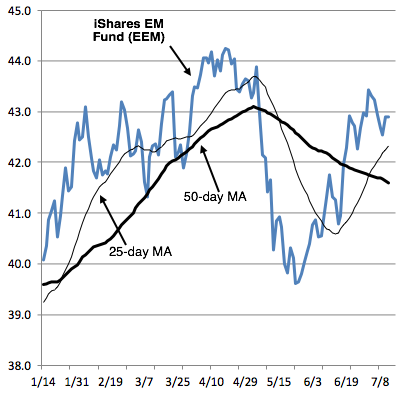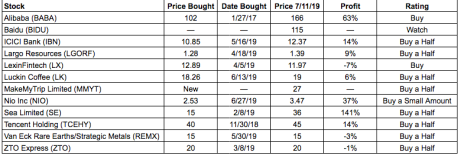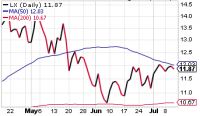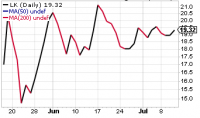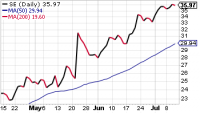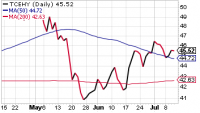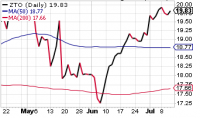Emerging and global markets had a good week with some standout performers such as NIO and SEA. Zero progress on U.S.-China talks was overshadowed by anticipated interest rate cuts. Today we recommend a stock from the Watch List and upgrade an idea in the portfolio.
Cabot Global Stocks Explorer 689
[premium_html_toc post_id="181436"]
Cabot Emerging Markets Timer
The Emerging Markets Timer is our disciplined method for staying on the right side of the emerging markets. The Timer is bullish when the index is above the lower of its two moving averages and that moving average is trending up.
The Emerging Markets Timer is still in bullish territory, telling us the intermediate-term trend continues to point up. You can see that the iShares EM Fund (EEM) has chopped around during the past three weeks, and there’s still some resistance in the 44 area to chew through. But the fund remains nicely above both its 25-day and 50-day moving averages, keeping the overall trend up.
Individual stocks have been relatively mixed, but happily we’re on most of the best-acting global stocks out there. Our advice remains the same: Remain mostly bullish, emphasizing some newer names with excellent growth prospects.
EEM Uptick, NIO Surges, China Buys Gold
Emerging markets (EEM) moved more solidly into bullish territory this week moving ahead of both its 20-day and 50-day moving averages.
Part of this story is of course the anticipation of lower interest rates, which normally lead to a weaker U.S. dollar and better returns for emerging markets.
Our stocks have for the most part moved with the market though NIO (NIO) is a standout – up 32% since being put back on the buy list two weeks ago.
Another steady performer has been SEA Limited (SEA), which has more than tripled so far this year and continues to outperform market. I’m upgrading from a hold to a buy today though I also encourage early investors in SEA to take some profits off the table.
China’s Economy vs. China’s Stock Market
One common misunderstanding that many investors share is that countries that have high economic growth rates always have great stock markets.
Sometimes this is true but oftentimes not.
For example, there is a significant and puzzling gap between China’s economy and its stock market.
This is an economy that’s managed to grow 35-fold since 1990, lifting more people out of poverty than there are people living in North America.
But the country’s stock market has managed to grow just 24-fold since it started operating in December 1990—with roller coaster volatility thrown into the mix.
Gold vs. the Greenback
The People’s Bank of China added nearly 16 tons of gold to its reserves in May, the sixth straight month China’s central bank has added to its gold reserves. India is also a big gold buyer. The Chinese have been working to move away from the dollar as the world’s international funding currency for years.
The gold buying binge is part of the Chinese government’s “determined diversification” away from dollar assets.
In addition, gold is gaining popularity among the world’s central banks.
Last year 15% of the world’s gold demand came from central banks, which collectively bought 652 tons, according to World Gold Council data.
Featured Stock
MakeMyTrip Limited (MMYT)
China’s Internet platform has spawned dozens of scalable companies, many of them listed on the NYSE.
But don’t forget about India.
Amazon has invested close to $4.7 billion in building its e-commerce operations in India.
Retail sales in India are close to $700 billion but only 10% of this is organized retail. Small mom-and-pop stores operate the rest. Amazon made an entry in this region in 2013 and has built a strong delivery network. It is also heavily investing in Amazon Pay, the digital wallet platform.
It seems smart to have some exposure to the fastest growing major economy in the world, as well as booming South Asia tourism.
And our new recommendation seems the best-positioned company to capitalize on all these favorable trends.
Founded in 2000 to serve the travel needs of the U.S.-based Indian community, MakeMyTrip has evolved into a leading travel company as India evolves into a digital marketplace by providing a comprehensive range of travel and travel-related services.
MakeMyTrip has made key acquisitions and strategic partnerships and its strong balance sheet should allow it to continue expanding its dominant market share.
Ctrip’s Alliance a Major Advantage
One key alliance is with Ctrip, China’s largest online travel group.
In 2016, Shanghai-based Ctrip invested about $180 million in MakeMyTrip, gaining it one board seat.
Ctrip recently announced that it intends to raise its position in MakeMyTrip to 49% in a share swap deal with Naspers.
Ctrip wanted even more shares but decided to stay under the 50% threshold to avoid regulatory scrutiny and political issues.
MakeMyTrip also has a 43% a year compound annual growth in gross merchandise value processed during the past few years but is not yet profitable.
India’s Great Potential
India’s economy is growing at a 7% clip—a bit faster than China’s—and its population is on a path to surpass China as the world’s most populous country sometime in the next decade.
Travel and tourism is the nation’s third largest foreign exchange earner contributing almost 10% of GDP and 8% of total employment.
India’s total travel and tourism investment is 3rd globally and a record-breaking 10 million foreign tourists travelled to India in 2017.
The Indian Government seeks to double this in 2020.
Despite the surge of foreign tourist arrivals, the domestic travel side of spending of $186 billion in 2017, 3rd largest in the world, accounted for 87% of direct travel and tourism GDP.
And as discretionary incomes and GDP per capita in India continue to trend upwards, these numbers and MakeMyTrip’s potential earnings and profits will also grow.
The government has also become more open to foreign investment in this sector and now permits 100% foreign investment in the hotels/tourist industry attracting $49 billion in capital investment in 2017 alone.
According to a recent McKinsey report, data costs in the country have fallen by 95% since 2013 and total online users will grow by another 40% to cross 750 million by 2023, driven by the continued adoption of smart phones.
Summing up this huge opportunity, industry experts forecast that India will become the third largest aviation market by 2022 and there are plans to double the number of operational airports over the next 20 years. BUY A HALF.
MakeMyTrip Limited (MMYT)
Model Portfolio
prices are as of 2:30 p.m.
Updates
Alibaba (BABA) sales are up 51%. And while Amazon has a relatively paltry 5% profit margin, Alibaba enjoys a 23% margin.
China’s online retail market was approximately $1.1 trillion last year.
And according to Forrester, a leading market research firm, even with the Chinese economy slowing, the value of that market will compound 8.5% a year over the next three years, hitting $1.8 trillion by 2022.
Alibaba subsidiary Lazada Group is Southeast Asia’s ecommerce leader and is expanding into India, which has posted a 53% compound annual growth rate of the country’s ecommerce sales from 2013 to 2018.
Baba’s cloud revenue continues to grow by leaps and bounds, as the unit’s revenue jumped 76% year-over-year in Baba’s fourth quarter.
BABA remains a great core China holding trading at an attractive valuation.BUY A FULL POSITION
ICICI Bank (IBN) remains a solid India play in the wake of President Narendra Modi’s recent re-election. There are still 191 million Indians without a bank account, which means a lot of potential new customers.
ICICI is capitalizing on this emerging growth trend with a blend of 60% retail and 40% corporate business. Its last quarter highlights its strength as retail loans were up 22% and core operating profit surged 26%. The bank has a healthy net interest margin of 3.72% and non-performing loans were down 50%.
This is a solid bank in a promising growth market. BUY A HALF.
LexinFintech (LX) should be performing better based on its strong fundamentals but needs to develop a longer and stronger uptrend to convince skeptics.
The company owns and operates a thriving online shopping mall that also offers installment loans. LX acquired nearly 705,000 new active users in its last quarter while keeping its 90-day delinquency ratio at an ultra-low 1.42%.
The company has signed strategic cooperation agreements with more than 100 more national banks, insurance companies and consumer finance companies. Earnings per share soared 228% on a 95% increase in revenue in the most recent quarter.
LX enjoys a sizable 42% profit margin with a 72% return on equity. This high-growth fintech idea is currently trading at less than 10 times forward earnings projections and I don’t think it will stay at these levels for long. BUY A FULL POSITION.
Luckin Coffee (LK), has leveled off after a strong start in our portfolio.
LK is challenging Starbucks’ dominance of China’s coffee market with a leaner and faster strategy. It aims to attract the average millennial as opposed to Starbucks’ more-affluent upper middle class—with cheaper prices, heavy promotions, quick delivery, and mobile ordering.
Since it was founded in 2017, the company has been expanding rapidly. As of March, Luckin had about 2,370 stores in 28 Chinese cities and is on track to surpass Starbucks by the end of 2019 as the largest coffee network in China by number of stores.
If you have not invested in Luckin, which is an aggressive idea that won’t be posting profits for some time, I encourage you to do so starting small up to a half position with a 20% trailing stop loss in place. BUY A HALF.
Sea Limited (SE) shares continue to outperform the market—with the stock more than tripling so far in 2019.
SE benefits from high-growth target markets outside of China in gaming, e-commerce and digital payments, primarily in seven Southeast Asian markets. Its gaming segment is the key driver and is projected by Morgan Stanley to expand 140% in 2019. The second driver is e-commerce, which is equally robust.
Revenue for the most recent quarter was almost triple that of the same quarter last year as its gaming platform, driven by a partnership with Tencent, had revenue growth of 169% year on year.
Depending on your entry point, feel free to take some profits off the table now but based on its continued outperformance I’m upgrading SEA to a buy. MOVE FROM HOLD A HALF TO BUY A HALF.
Tencent (TCEHY) Tencent is up 16% so far in 2019, thanks to regulators in China easing up on gaming restrictions (40% of revenue).
Tencent is one of the largest tech companies in the world and is primarily known for its app WeChat, which is used for basically everything: communicating with friends and family, ordering a cab, doing payments.
Its operating revenue comes primarily from gaming and social networks. More and more, however, the company has been investing into other tech companies and is evolving into a diversified tech fund.
This is a strong and dominant company. I encourage you to buy a half position at these levels if you have not yet done so. BUY A HALF.
Van Eck Rare Earths/Strategic Metals (REMX), lost some ground this week but keep in mind its 11% plus dividend yield.
A basket of rare metal and rare earth stocks, this ETF is a hedge on U.S.-China tensions, as indications that China may withhold these critical materials from U.S. companies. China’s dominance is again headline news and this position is worth buying up to 18. BUY A HALF.
ZTO Express (ZTO) is up 15% from its June 6 low. Based in Shanghai, ZTO is one of the largest express delivery companies, not just in China but globally.
It offers services to millions of traditional merchants, e-commerce sites, and online sellers using a proprietary tracking system, a state-of-the-art transportation management system, and more than 4,500 trucks, as well as hundreds of business partners.
ZTO covers more than 96% of China’s cities. Alibaba (NYSE: BABA) and JD (Nasdaq: JD) account for more than 85% of China’s online sales. Last year Alibaba led a consortium of investors that put $1.38 billion to work in ZTO in exchange for a 10% stake.
China is also the world’s largest exporter, of course. And ZTO serves foreign customers through partnerships with many international express delivery companies. Finally, revenue was up significantly year over year, to $682 million and ZTO maintains a leading 17% market position in China. Any visible progress on U.S.-China trade talks should lead to this stock moving. BUY A HALF.
Speculative Portfolio Recommendation
Largo Resources (LGORF) moved up incrementally during the past week and now trades at less than five times earnings. Rare metals are once again in the media spotlight as China threatens to keep more of these key materials at home and potentially deny access to international companies.
Please keep in mind that this is a speculative play on vanadium, which is used to strengthen steel, and is a key ingredient for large-scale grid electrical energy storage batteries. BUY A HALF.
NIO (NIO), a speculative, aggressive recommendation continues its uptrend (up 32% in two weeks) and relative strength since being added to the portfolio.
Automobile sales in China rose 4.9% in June, according to preliminary figures from the China Passenger Car Association. The monthly gain broke a streak of 12 straight months of lower auto sales in the nation.
NIO had drifted downward from a 2019 high of $10 to a low of $2.35 about three weeks ago.
Since then, a tenuous uptrend is developing and NIO seems to have all the negatives on the table. It is a speculative stock and will likely be a bit volatile but I sense an upside as well given that the Chinese government is firmly behind electric vehicles. BUY SMALL POSITION.
Watch List
Baidu (BIDU) seems to be building a bottom in the $112- $115 range and is trading at less than 11 times forward earnings. Baidu’s net cash as well as stakes in iQIYI and Ctrip.com represent more than half its market capitalization.
While its revenue rose 15% annually during the quarter, most of that growth came from its streaming unit iQiyi (NASDAQ: IQ) instead of its core advertising business.
Baidu’s total operating expenses surged 53% annually, due to higher content acquisition costs for IQ, and investments in artificial intelligence and autonomous driving.
[premium_html_footer]
Send questions or comments to carl@cabotwealth.com.
Cabot Global Stocks Explorer • 176 North Street, Salem, MA 01970 • www.cabotwealth.com
All Cabot Global Stocks Explorer buy and sell recommendations are made in issues or updates and posted on the Cabot subscribers’ website. Sell recommendations may also be sent to subscribers as special alerts via email. To calculate the performance of the hypothetical portfolio, Cabot “buys” and “sells” at the midpoint of the high and low prices of the stock on the day following the recommendation. Cabot’s policy is to sell any stock that shows a loss of 20% in a bull market (15% in a bear market) from our original buy price, calculated using the current closing (not intra-day) price. Subscribers should apply loss limits based on their own personal purchase prices.
THE NEXT CABOT GLOBAL STOCKS EXPLORER ISSUE IS SCHEDULED FOR July 25, 2019
We appreciate your feedback on this issue. Follow the link below to complete our subscriber satisfaction survey: Go to: www.surveymonkey.com/chinasurvey
Cabot Global Stocks Explorer is published by Cabot Wealth Network, an independent publisher of investment advice since 1970. Neither Cabot Wealth Network, nor our employees, are compensated in any way by the companies whose stocks we recommend. Sources of information are believed to be reliable, but they are in no way guaranteed to be complete or without error. Recommendations, opinions or suggestions are given with the understanding that subscribers acting on information assume all risks involved. © Cabot Wealth Network 2019. Copying and/or electronic transmission of this report is a violation of the copyright law. For the protection of our subscribers, if copyright laws are violated, the subscription will be terminated. To subscribe or for information on our privacy policy, visit www.cabotwealth.com, write to support@cabotwealth.com or call 978-745-5532.
[/premium_html_footer]



